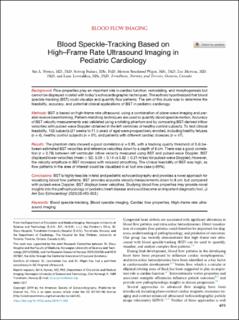| dc.contributor.author | Nyrnes, Siri Ann | |
| dc.contributor.author | Fadnes, Solveig | |
| dc.contributor.author | Wigen, Morten Smedsrud | |
| dc.contributor.author | Mertens, Luc | |
| dc.contributor.author | Løvstakken, Lasse | |
| dc.date.accessioned | 2021-04-27T07:20:17Z | |
| dc.date.available | 2021-04-27T07:20:17Z | |
| dc.date.created | 2020-01-26T16:56:49Z | |
| dc.date.issued | 2020 | |
| dc.identifier.citation | Journal of the American Society of Echocardiography. 2020, 33 (4), 493-503.e5. | en_US |
| dc.identifier.issn | 0894-7317 | |
| dc.identifier.uri | https://hdl.handle.net/11250/2739757 | |
| dc.description.abstract | Background: Flow properties play an important role in cardiac function, remodeling, and morphogenesis but cannot be displayed in detail with today’s echocardiographic techniques. The authors hypothesized that blood speckle-tracking (BST) could visualize and quantify flow patterns. The aim of this study was to determine the feasibility, accuracy, and potential clinical applications of BST in pediatric cardiology. Methods: BST is based on high–frame rate ultrasound, using a combination of plane-wave imaging and parallel receive beamforming. Pattern-matching techniques are used to quantify blood speckle motion. Accuracy of BST velocity measurements was validated using a rotating phantom and by comparing BST-derived inflow velocities with pulsed-wave Doppler obtained in the left ventricles of healthy control subjects. To test clinical feasibility, 102 subjects (21 weeks to 11.5 years of age) were prospectively enrolled, including healthy fetuses (n = 4), healthy control subjects (n = 51), and patients with different cardiac diseases (n = 47). Results: The phantom data showed a good correlation (r = 0.95, with a tracking quality threshold of 0.4) between estimated BST velocities and reference velocities down to a depth of 8 cm. There was a good correlation (r = 0.76) between left ventricular inflow velocity measured using BST and pulsed-wave Doppler. BST displayed lower velocities (mean 6 SD, 0.59 6 0.14 vs 0.82 6 0.21 m/sec for pulsed-wave Doppler). However, the velocity amplitude in BST increases with reduced smoothing. The clinical feasibility of BST was high, as flow patterns in the area of interest could be visualized in all but one case (>99%). Conclusions: BST is highly feasible in fetal and pediatric echocardiography and provides a novel approach for visualizing blood flow patterns. BST provides accurate velocity measurements down to 8 cm, but compared with pulsed-wave Doppler, BST displays lower velocities. Studying blood flow properties may provide novel insights into the pathophysiology of pediatric heart disease and could become an important diagnostic tool. | en_US |
| dc.language.iso | eng | en_US |
| dc.publisher | Elsevier, American Society of Echocardiography | en_US |
| dc.relation.uri | https://www.sciencedirect.com/science/article/pii/S0894731719311149 | |
| dc.rights | Attribution-NonCommercial-NoDerivatives 4.0 Internasjonal | * |
| dc.rights.uri | http://creativecommons.org/licenses/by-nc-nd/4.0/deed.no | * |
| dc.title | Blood Speckle-Tracking Based on High–Frame Rate Ultrasound Imaging in Pediatric Cardiology | en_US |
| dc.type | Peer reviewed | en_US |
| dc.type | Journal article | en_US |
| dc.description.version | publishedVersion | en_US |
| dc.source.pagenumber | 493-503.e5 | en_US |
| dc.source.volume | 33 | en_US |
| dc.source.journal | Journal of the American Society of Echocardiography | en_US |
| dc.source.issue | 4 | en_US |
| dc.identifier.doi | 10.1016/j.echo.2019.11.003 | |
| dc.identifier.cristin | 1782227 | |
| dc.relation.project | Norges forskningsråd: 237887 | en_US |
| dc.relation.project | Norges forskningsråd: 230455 | en_US |
| dc.relation.project | Samarbeidsorganet mellom Helse Midt-Norge og NTNU: 2014/23203 | en_US |
| cristin.ispublished | true | |
| cristin.fulltext | original | |
| cristin.qualitycode | 2 | |

